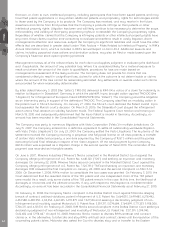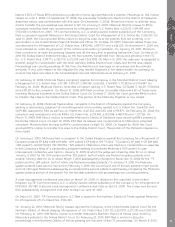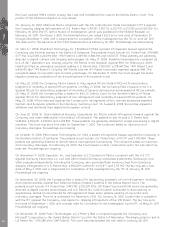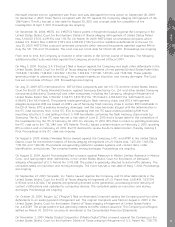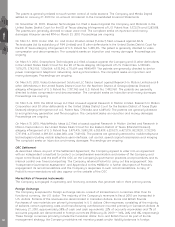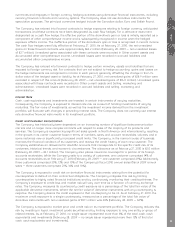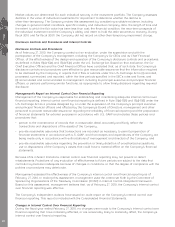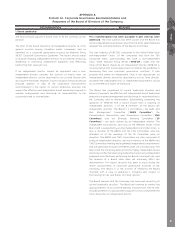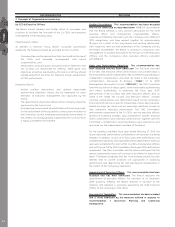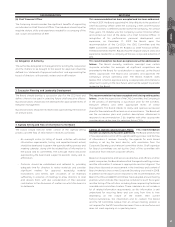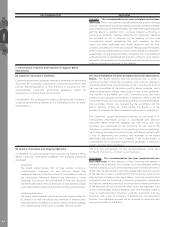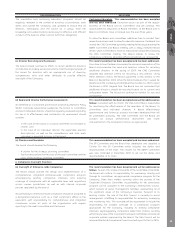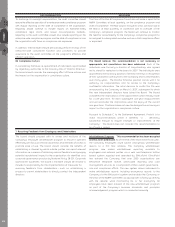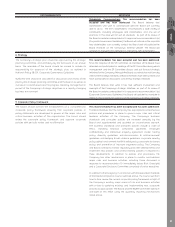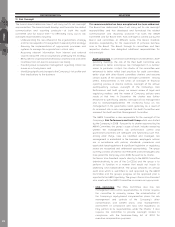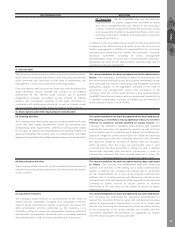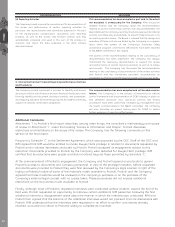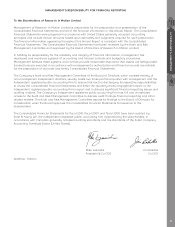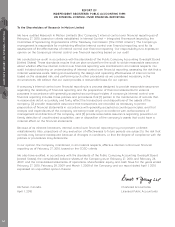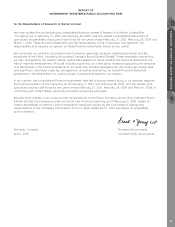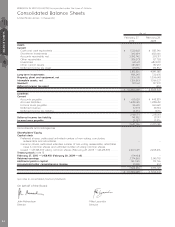Blackberry 2010 Annual Report Download - page 52
Download and view the complete annual report
Please find page 52 of the 2010 Blackberry annual report below. You can navigate through the pages in the report by either clicking on the pages listed below, or by using the keyword search tool below to find specific information within the annual report.
RECOMMENDATION RESPONSE
Protocols: This recommendation has been accepted and has been
addressed. There is an unwritten, but well understood, protocol already
in place. Materials for quarterly meetings are to be provided one week
prior to the Board/committee meetings. This timeframe is generally met
and the Board is satisfied that it receives material sufficiently in
advance of quarterly meetings. Materials for intervening meetings
are provided as far in advance of the meeting as time and
circumstances permit, recognizing that such meetings, by their
nature, are often unplanned and involve situations that are fluid,
complex and difficult to time with precision. Recognizing the benefits
of the Company’s entrepreneurial culture, which enables it to respond to
opportunities more quickly than other companies of its size, the Board
understands that circumstances do and will continue to arise where it
will need to be available on shorter notice and with less time to review
materials provided in advance of the meeting.
5. Infrastructure, Practices and Processes to Support Board
Effectiveness
(a) Corporate Governance Guidelines
Corporate governance guidelines should be developed to define and
document the Company’s approach to corporate governance and
provide direction/guidance to help directors in carrying out their
responsibilities. Corporate governance guidelines should be
reviewed on an annual basis by the board.
Consideration should be given to publicly disclosing the Company’s
corporate governance guidelines as it is a leading practice for larger
organizations.
This recommendation has been accepted and will be addressed as
follows. The Board believes that the Company has in place a
significant number of policies, procedures and practices relating to
corporate governance, including those set out in charters for each of
the three committees of the Board and the Board mandate, which
address governance matters often found in such issuer guidelines.
The charters of the A&RM and CNG Committees have also been
enhanced and adopted by the Board in December 2009. A new SP
Committee Charter was also adopted by the Board in December 2009.
The committee charters are reviewed by the committees and the
Board annually. Finally, as noted above, the Board is in the
process of reviewing the Board mandate with a view to updating it.
The Company’s current governance practices are disclosed in its
management information circular in accordance with National
Instrument 58-101. While the NASDAQ and TSX listing rules and
securities laws applicable to the Company do not require the
Company to publicly disclose its corporate governance guidelines,
the Company will review its current charters and Board mandate with
a view to augmenting the charters and mandate as the Board
determines appropriate for the Company. If the Board adopts a
consolidated set of corporate governance guidelines, it intends to
publicly disclose those guidelines.
(b) Director Orientation and Ongoing Education
As identified as corporate governance practices by National Policy
58-201, Corporate Governance Guidelines, the following should be
developed:
- Orientation:
The board should ensure that all new directors receive a
comprehensive orientation. All new directors should fully
understand the role of the board and its committees, as well as
the contribution individual directors are expected to make
(including, in particular, the commitment of time and resources
that the issuer expects from its directors). All new directors should
also understand the nature and operation of the issuer’s business.
- Continuing Education:
The board should provide continuing education opportunities for
all directors, so that individuals may maintain or enhance their
skills and abilities as directors, as well as to ensure their knowledge
and understanding of the issuer’s business remains current.
The first two paragraphs of this recommendation come from
NP 58-201. The third is a Protiviti recommendation.
Orientation: This recommendation has been accepted and has
been addressed. All new directors of the Company now receive a
comprehensive orientation. This includes: receiving a detailed briefing
from the Company as part of the selection process; meeting the Chair
of the CNG, the lead director and other independent directors as part
of the selection process; a briefing from the Company’s internal and
external legal counsel on their legal duties, corporate and securities
obligations and the Company’s corporate governance procedures
and policies; attending a product working session; meeting with each
of the executive officers and certain other senior management, such
as the Vice-President, Investor Relations and Vice President, Legal in
order to understand the Company’s products, operations and key
functions; and a tour of Company manufacturing and operations
facilities. The orientation process will be reviewed in connection with
new appointments to the Board.
MD&A
44


